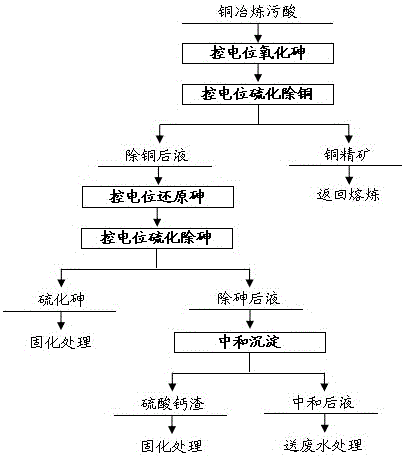Potential-control selective separation method of copper smelting acidic wastewater
A copper smelting and selective technology, applied in chemical instruments and methods, water pollutants, metallurgical wastewater treatment, etc., can solve the problems of increasing waste slag stacking and treatment difficulties, heavy metal precipitation into gypsum slag, incomplete removal of valuable metals, etc. problems, to achieve the effect of low production cost, small investment in equipment, and low labor intensity
- Summary
- Abstract
- Description
- Claims
- Application Information
AI Technical Summary
Problems solved by technology
Method used
Image
Examples
Embodiment 1
[0034] The main components of dirty acid produced during the smelting process of a copper concentrate oxygen-enriched bottom blowing furnace in a domestic enterprise are (g / L): Cu4.2, As12.4, Bi0.8 and Zn1.5. The mass percentage of industrial grade hydrogen peroxide is not less than 27.5%, the mass percentage of industrial grade sodium sulfite is not less than 95.0%, and the mass percentage of industrial grade sodium sulfide is not less than 60.0%.
[0035] Add the above-mentioned industrial hydrogen peroxide to the polluted acid, control the metal ion mixed potential of the whole solution at 550mV, continue stirring for 20 minutes after the potential is stabilized, add solid sodium sulfide to the oxidized solution at a temperature of 80°C, and control the mixed metal ion potential of the solution At 225mV, after the potential of the solution is stabilized and the stirring is continued for 60 minutes, solid-liquid separation occurs. The solid product is copper sulfide concentra...
PUM
 Login to View More
Login to View More Abstract
Description
Claims
Application Information
 Login to View More
Login to View More - R&D
- Intellectual Property
- Life Sciences
- Materials
- Tech Scout
- Unparalleled Data Quality
- Higher Quality Content
- 60% Fewer Hallucinations
Browse by: Latest US Patents, China's latest patents, Technical Efficacy Thesaurus, Application Domain, Technology Topic, Popular Technical Reports.
© 2025 PatSnap. All rights reserved.Legal|Privacy policy|Modern Slavery Act Transparency Statement|Sitemap|About US| Contact US: help@patsnap.com

